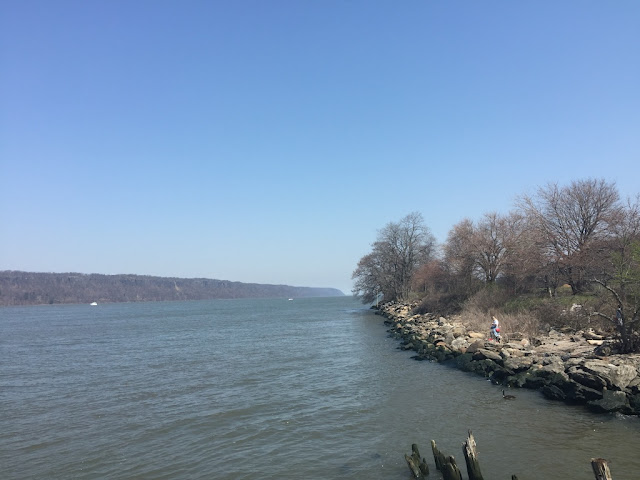New Yorkers had a real taste of spring the past couple of days, a much longed-for break from the long winter. The warm weather brought throngs of people to the parks. Central Park looked especially crowded, from all the evidence on social media. In northern Manhattan, Fort Tryon Park was plenty busy, but
Inwood Hill Park, a little wilder and even more remote from the downtown crowd, felt luxuriously available for a more contemplative walk in the park. Just enough people were there.
 |
| At the water's edge. View of the Hudson River near the west end of Dyckman Street. |
The first days of spring invite reveries about water and the promise of voyages on rivers and seas. "Manhattoes," as Herman Melville calls us in the opening chapter of
Moby Dick, naturally gravitate to the shoreline and “must get just as nigh the water as they possibly can without falling.” I had originally planned to walk through the Heather Garden of Fort Tryon Park, but the same mysticism that Melville experienced drew me west on Dyckman Street to the
Hudson River.
 |
| View of the Hudson River and Palisades of New Jersey from a high path in Inwood Hill Park. |
A small fenced pier sits out in the water adjacent to La Marina, a boisterous party spot at night. During the day, a few fishermen occupy the space. On my stop at the pier, I saw a few parents playing with their children, some solo walkers wandering around, a flock of geese swimming about, and a paddling of ducks loudly engaged in a domestic argument. The spot affords views of the Palisades on the New Jersey side of the Hudson River as well as The Cloisters on the hill to the south.
 |
| The Spuyten Duyvil Bridge. The bridge is in the open position. |
The spot also provides views of the George Washington Bridge to the south, and on a clear day, the shimmering new Tappan Zee Bridge way to the north. A walk north along the low path west of Inwood Hill Park's athletic fields and again up to a higher path via a pedestrian staircase takes in views of additional bridges. These include the Spuyten Duyvil Bridge, a swing bridge used by Amtrak at the confluence of the Hudson and Spuyten Duyvil Creek, and the Henry Hudson Bridge, once the world’s longest fixed arch bridge built in 1936.
 |
| Blooming plant on the path leading under the Henry Hudson Bridge. |
Spuyten Duyvil Creek is actually a tidal estuary that connects the Hudson River to the Harlem Ship Canal. The whole western part of these waterways was excavated and reengineered over several decades, severing natural and geographical connections between northern Manhattan and the Bronx.
 |
| The path curves around and down to the salt marsh. |
This path in Inwood Hill Park curves under the Henry Hudson Bridge to dramatic effect before sloping down to the soccer field and the salt marsh. At the bottom of the trail, Shorakapok Rock marks the spot where Peter Minuit allegedly purchased Manhattan for 60 guilders.
A map:
Images by Walking Off the Big Apple from April 14, 2018.









